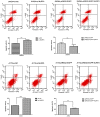NLRP3 in human glioma is correlated with increased WHO grade, and regulates cellular proliferation, apoptosis and metastasis via epithelial-mesenchymal transition and the PTEN/AKT signaling pathway
- PMID: 30015880
- PMCID: PMC6065456
- DOI: 10.3892/ijo.2018.4480
NLRP3 in human glioma is correlated with increased WHO grade, and regulates cellular proliferation, apoptosis and metastasis via epithelial-mesenchymal transition and the PTEN/AKT signaling pathway
Abstract
Glioma is the most prevalent and fatal primary tumor of the central nervous system in adults, while the development of effective therapeutic strategies in clinical practice remain a challenge. Nucleotide-binding domain leucine-rich family pyrin-containing 3 (NLRP3) has been reported to be associated with tumorigenesis and progression; however, its expression and function in human glioma remain unclear. The present study was designed to explore the biological role and potential mechanism of NLRP3 in human glioma. The results demonstrated that overexpression of NLRP3, apoptosis-associated speck-like protein containing a caspase-recruitment domain (ASC), caspase‑1 and interleukin (IL)‑1β protein in human glioma tissues were significantly correlated with higher World Health Organization grades. The in vitro biological experiments demonstrated that NLRP3 downregulation significantly inhibited the proliferation, migration and invasion, and promoted the apoptosis of SHG44 and A172 glioma cell lines. Furthermore, western blot assays revealed that the downregulation of NLRP3 significantly reduced the expression of ASC, caspase‑1 and IL‑1β protein. Furthermore, NLRP3 knockdown caused the inhibition of epithelial-mesenchymal transition (EMT), and inhibited the phosphorylation of AKT serine/threonine kinase (AKT) and phosphorylation of phosphatase and tensin homolog (PTEN). Consistently, the upregulation of NLRP3 significantly increased the expression of ASC, caspase‑1, IL‑1β and phosphorylated-PTEN, promoted proliferation, migration, invasion and EMT, inhibited apoptosis, and activated the AKT signaling pathway. The data of the present study indicate that NLRP3 affects human glioma progression and metastasis through multiple pathways, including EMT and PTEN/AKT signaling pathway regulation, enhanced inflammasome activation, and undefined inflammasome-independent mechanisms. Understanding the biological effects of NLRP3 in human glioma and the underlying mechanisms may offer novel insights for the development of glioma clinical therapeutic strategies.
Figures








References
MeSH terms
Substances
LinkOut - more resources
Full Text Sources
Other Literature Sources
Research Materials
Miscellaneous

